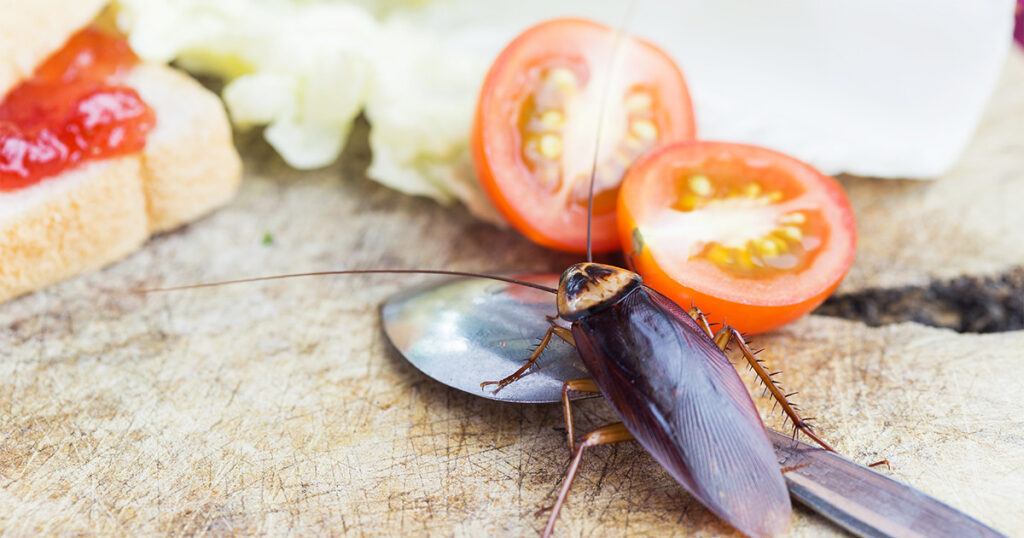The kitchen is one of the most vulnerable areas in a home when it comes to cockroach infestations. Cockroaches are known for their ability to thrive in warm, moist environments, making kitchens the perfect breeding grounds for these pests. While many types of cockroaches can invade your kitchen, identifying the specific species can help you understand their behavior, risks, and the best ways to control them. In this article, we’ll explore the most common types of cockroaches found in kitchens and offer tips on how to manage these unwelcome guests.
1. German Cockroach (Blattella germanica)
The German cockroach is by far the most common cockroach species found in kitchens. It is notorious for its rapid reproduction and ability to spread quickly within households, especially in food-related environments.
- Appearance: The German cockroach is small, measuring about 1/2 to 5/8 inch (13–16 mm) in length. It is light brown or tan with two dark, parallel stripes on its thorax.
- Habitat: German cockroaches are primarily attracted to kitchens and bathrooms, particularly areas near food and water. They are commonly found behind kitchen appliances like refrigerators, stoves, and dishwashers, as well as in cracks, crevices, and pantry areas.
- Behavior: These cockroaches prefer warm, humid environments and are nocturnal, becoming active at night. They are highly social and often found in large groups.
- Risks: German cockroaches are known to spread pathogens like Salmonella and E. coli, and their presence can trigger allergies or asthma, especially in children.
2. American Cockroach (Periplaneta americana)
The American cockroach is another species commonly found in kitchens, especially in warmer climates. Known for its large size and ability to fly short distances, the American cockroach prefers dark, damp areas but can also thrive in kitchens if food sources are available.
- Appearance: Adult American cockroaches are large, measuring 1.5 to 2 inches (38–51 mm) in length. They are reddish-brown with a yellowish margin on their thorax and have wings that allow them to fly.
- Habitat: While these cockroaches are more likely to be found in basements, sewers, and utility rooms, they can invade kitchens, especially in homes with plumbing issues or poor sanitation. They are often seen around garbage areas or under sinks.
- Behavior: American cockroaches are nocturnal and often prefer dark, moist environments. They are excellent at scavenging and will feed on food scraps, grease, and organic matter.
- Risks: Like German cockroaches, American cockroaches can carry diseases such as Salmonella and can trigger allergic reactions. Their presence in kitchens can contaminate food and surfaces.
3. Oriental Cockroach (Blatta orientalis)
The Oriental cockroach, also known as the “water bug,” is typically found in cool, damp environments. While it’s not as commonly associated with kitchen environments as the German or American cockroaches, it can still infest kitchens, especially in homes with plumbing issues or high humidity.
- Appearance: Oriental cockroaches are dark brown or black, with a glossy appearance. They are approximately 1 to 1.25 inches (25–32 mm) in length, and unlike other species, they do not have fully developed wings, making them less mobile.
- Habitat: These cockroaches prefer cool, moist areas and are often found in basements, crawl spaces, and under sinks. If there’s a water leak or moisture buildup in your kitchen, the Oriental cockroach may invade.
- Behavior: Oriental cockroaches are nocturnal and tend to stay hidden during the day. They are more likely to be found in areas where food scraps and moisture accumulate, such as under the sink or behind appliances.
- Risks: Oriental cockroaches are not known to carry as many diseases as other cockroach species, but they can still contaminate food and surfaces with their feces and body parts. They may also trigger allergies in sensitive individuals.
4. Brown-Banded Cockroach (Supella longipalpis)
The brown-banded cockroach is smaller and less common than other cockroach species, but it can still infest kitchens, especially in homes with warm, dry conditions.
- Appearance: Brown-banded cockroaches are 1/2 to 3/4 inch (13–19 mm) in length, with light brown or tan bodies and two distinct, light-colored bands running across their wings and abdomen.
- Habitat: Unlike other cockroaches that prefer damp environments, brown-banded cockroaches are more likely to be found in warm, dry areas. They are often found in higher places, such as ceilings, walls, and inside cabinets or pantries.
- Behavior: Brown-banded cockroaches are nocturnal and often hide in places that provide shelter from light. They are particularly attracted to areas with food sources, such as pantry shelves or the corners of kitchen cabinets.
- Risks: While they are not as likely to spread diseases as German or American cockroaches, brown-banded cockroaches can still carry bacteria and allergens. Their droppings can also contaminate food, posing a potential health risk.
5. Smoky Brown Cockroach (Periplaneta fuliginosa)
The smoky brown cockroach is a large, dark species that is more common in warm, humid environments, especially in the southern United States. While they are typically outdoor pests, they can occasionally invade kitchens if food and water sources are abundant.
- Appearance: Smoky brown cockroaches are 1 to 1.5 inches (25–38 mm) long, with a dark brown or mahogany-colored body and large, expansive wings.
- Habitat: These cockroaches are typically found outdoors, living under mulch, leaves, and wood piles. However, they can enter homes through open windows, doors, or plumbing lines and may end up in kitchens, particularly in warmer months.
- Behavior: Smoky brown cockroaches are nocturnal and often enter kitchens at night in search of food. They are attracted to damp, humid environments and will often infest homes with high moisture levels.
- Risks: Smoky brown cockroaches are not as likely to infest kitchens as German or American cockroaches, but they can still carry bacteria and allergens that may contaminate food and surfaces.
6. Wood Cockroach (Parcoblatta spp.)

The wood cockroach is an outdoor species that is less likely to infest kitchens directly, but it can occasionally be found indoors, especially if there is an infestation of outdoor cockroaches near the kitchen.
- Appearance: Wood cockroaches are 1 to 1.25 inches (25–32 mm) long, with a reddish-brown body and long wings. They are similar in appearance to smoky brown cockroaches but are smaller and not as dark.
- Habitat: These cockroaches prefer wooded areas and can be found under bark, in leaf litter, or around tree trunks. If they find their way inside, they are most often found in basements or kitchens near doors or windows.
- Behavior: Wood cockroaches are generally not considered a major pest and don’t usually infest kitchens unless they are attracted by moisture or food sources. They are more likely to be found near the exterior of the home.
- Risks: Wood cockroaches are not a significant health risk, but like other cockroaches, they can carry bacteria that may contaminate food if they enter the kitchen.
How to Prevent Cockroaches in the Kitchen
Cockroach infestations in the kitchen can be both a nuisance and a health hazard. Here are some steps you can take to prevent cockroaches from taking over your kitchen:
- Maintain Cleanliness: Keep your kitchen clean by wiping down counters, cleaning up food spills immediately, and regularly taking out the trash. This helps remove food sources that attract cockroaches.
- Seal Cracks and Gaps: Cockroaches can enter through even the smallest cracks and gaps in walls, windows, and doors. Seal any openings to prevent their entry.
- Fix Leaks: Cockroaches are attracted to moisture. Repair any plumbing leaks and ensure there are no standing water sources around sinks, dishwashers, or refrigerators.
- Store Food Properly: Store food in airtight containers, and avoid leaving food exposed on countertops or in cabinets.
- Use Baits and Traps: If you suspect a cockroach infestation, use cockroach baits or traps to monitor and reduce the population.
- Professional Pest Control: For a large or persistent infestation, it may be necessary to call a professional pest control service to eliminate cockroaches and prevent further problems.
Conclusion
The kitchen is one of the most attractive environments for cockroaches, and several species can invade it, including the German, American, and Oriental cockroaches. While each type of cockroach has different habits and preferences, they all pose potential health risks by contaminating food and spreading disease. By taking preventive measures, maintaining a clean kitchen, and addressing infestations early, you can effectively protect your home from these unwelcome pests.



